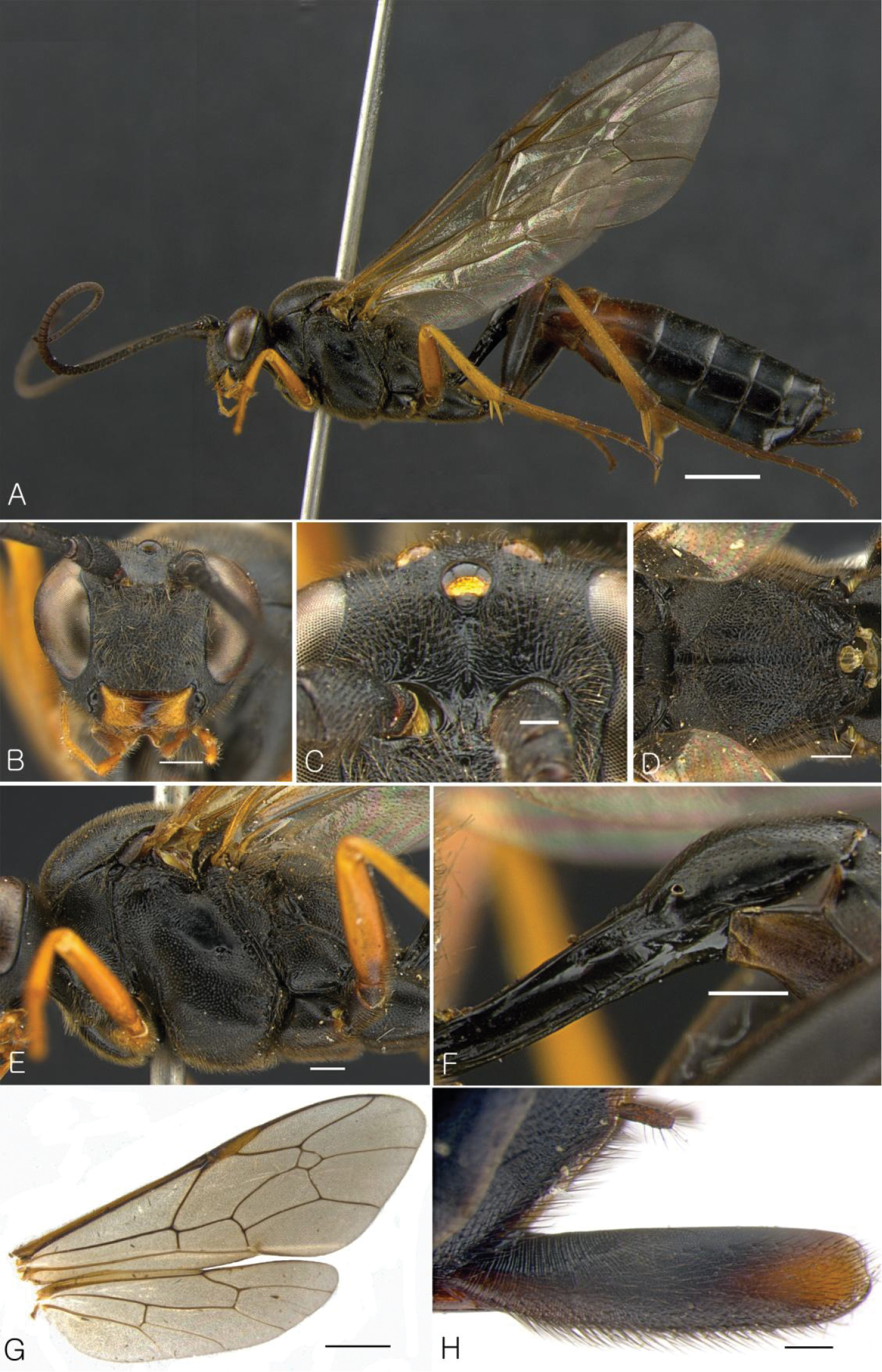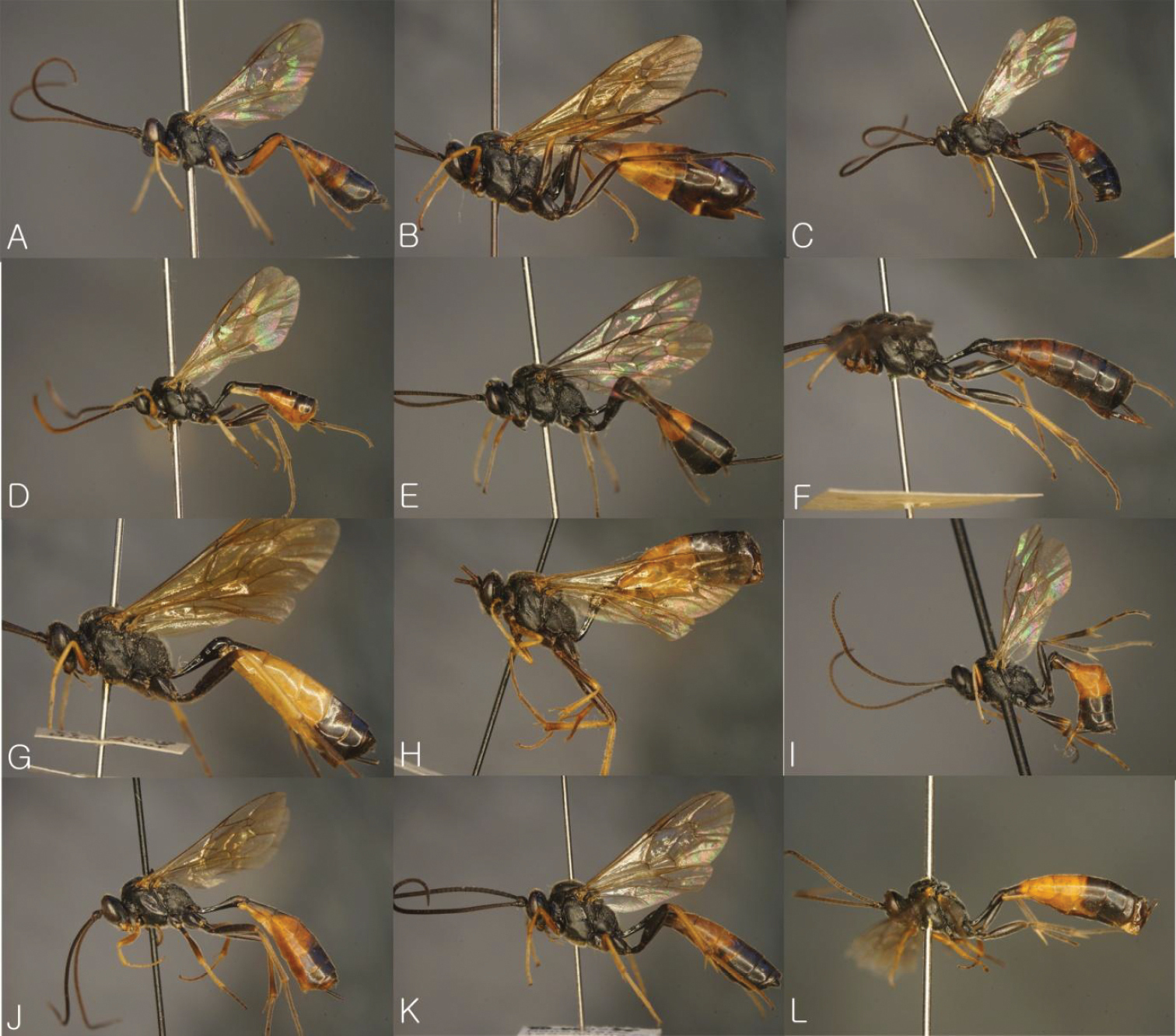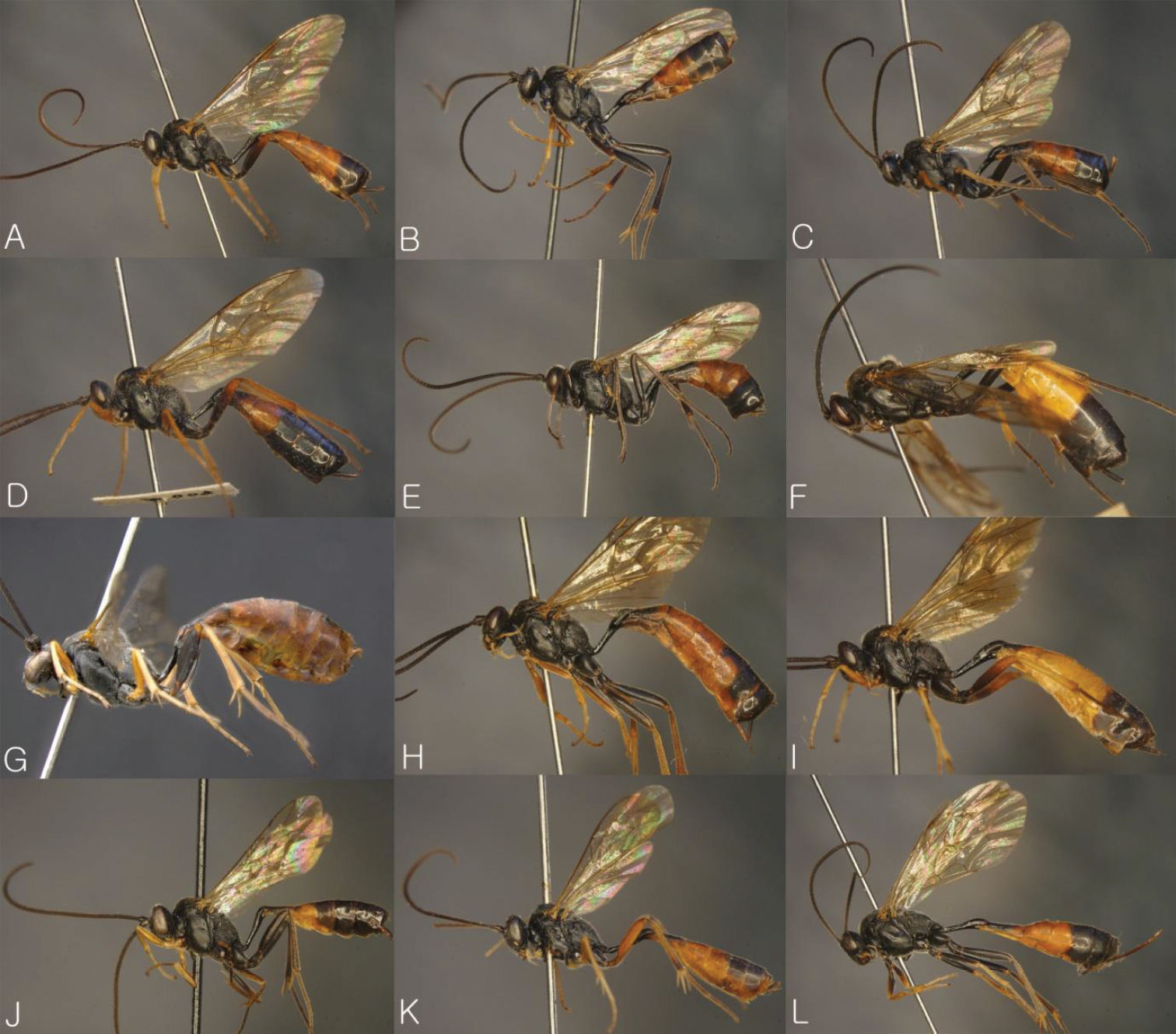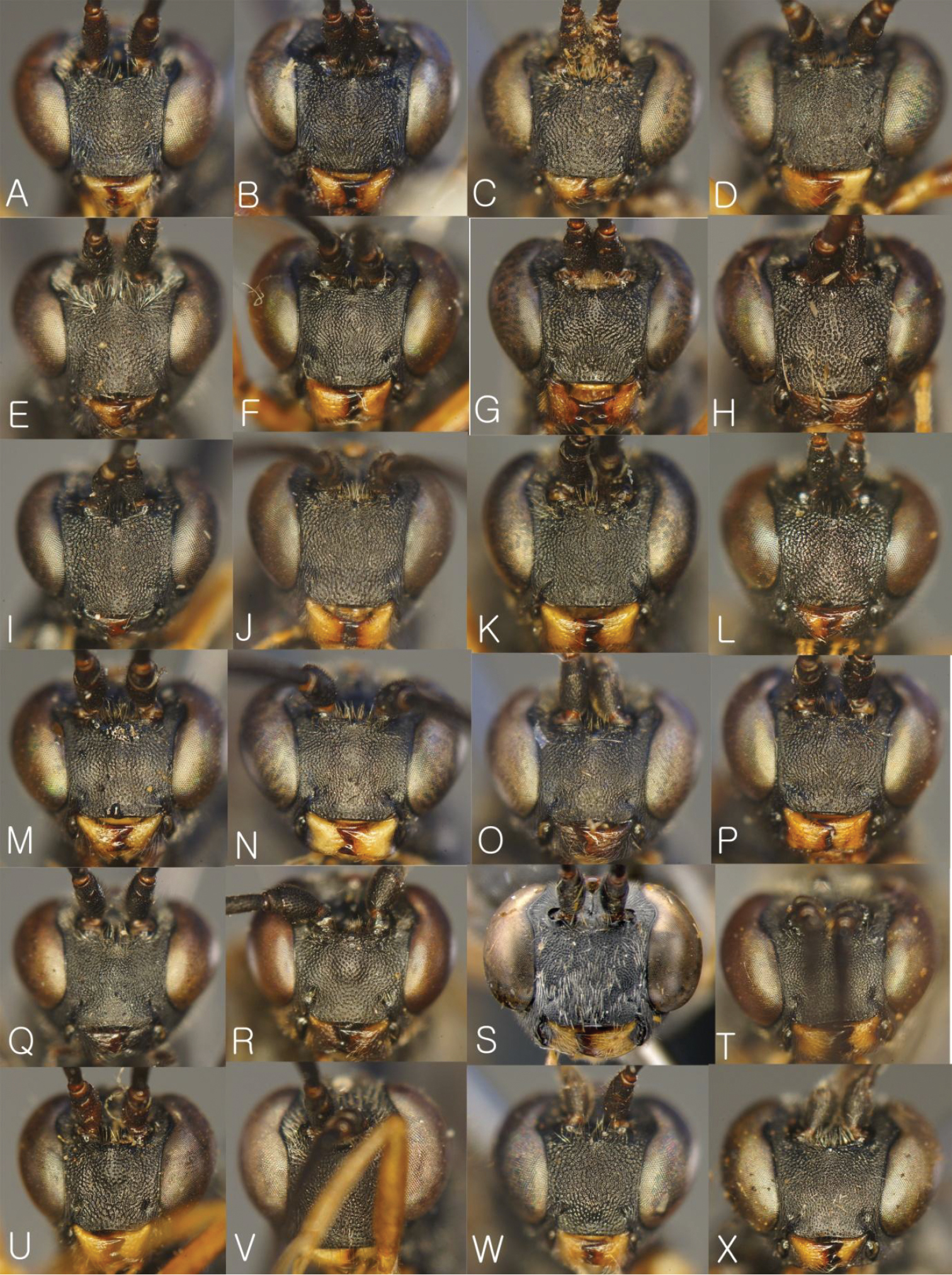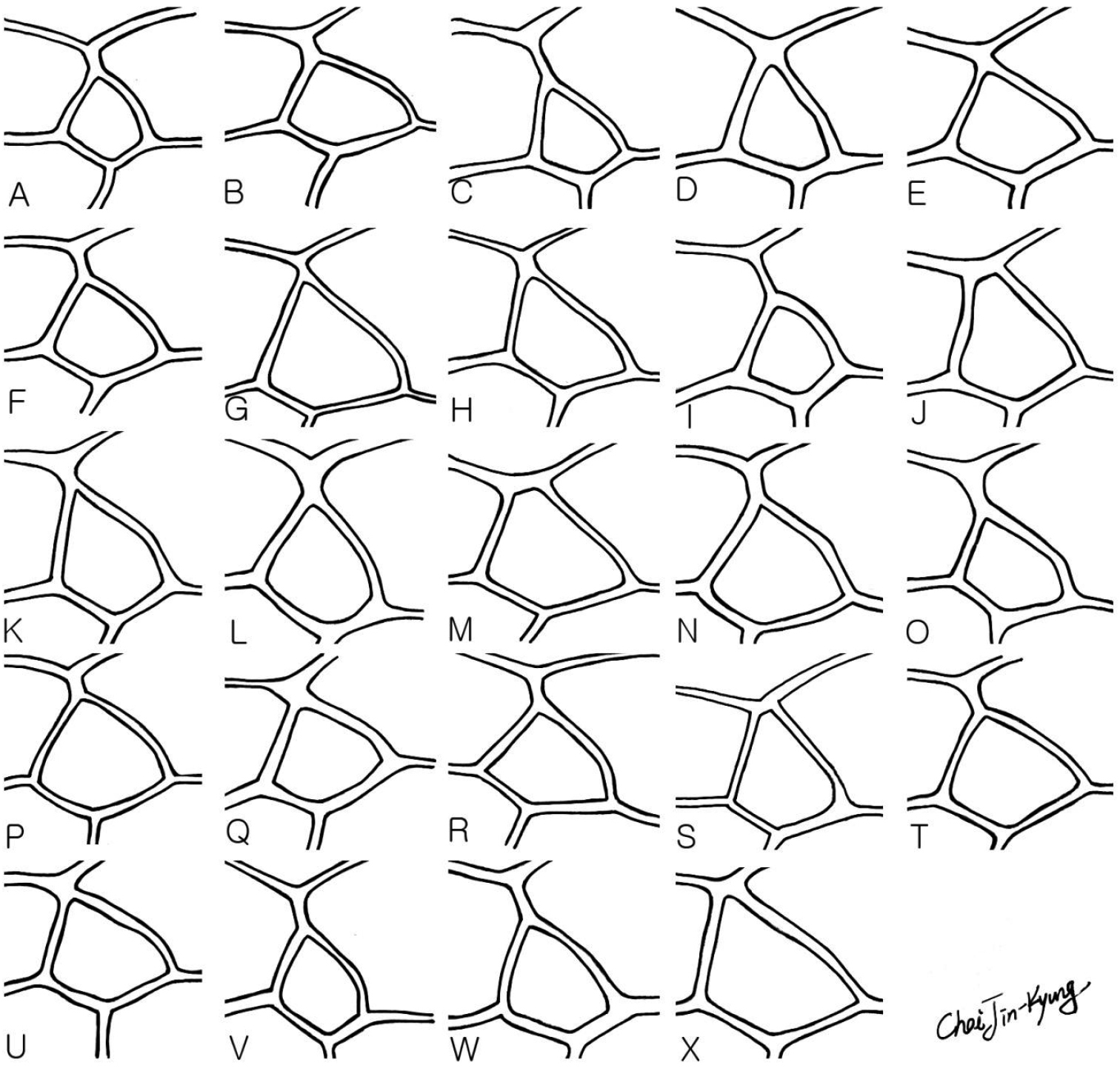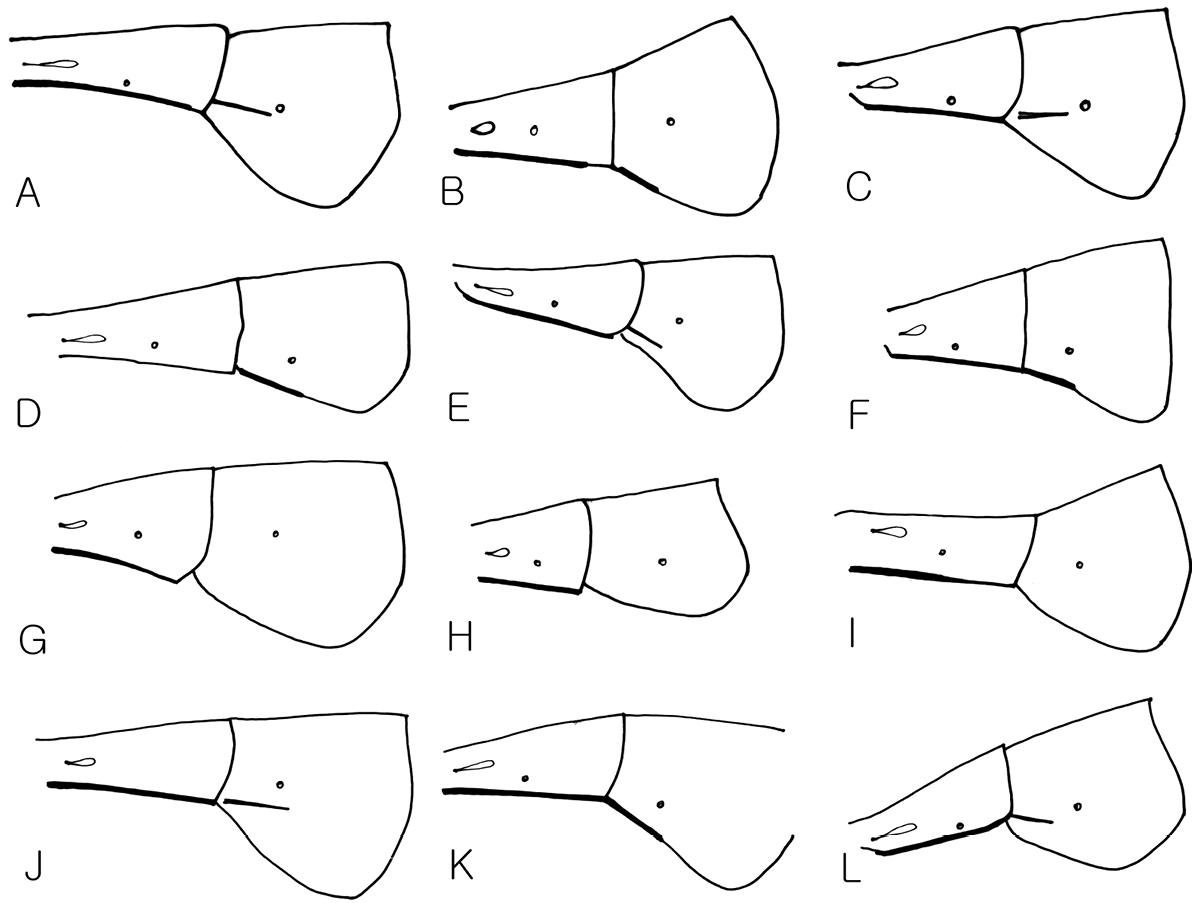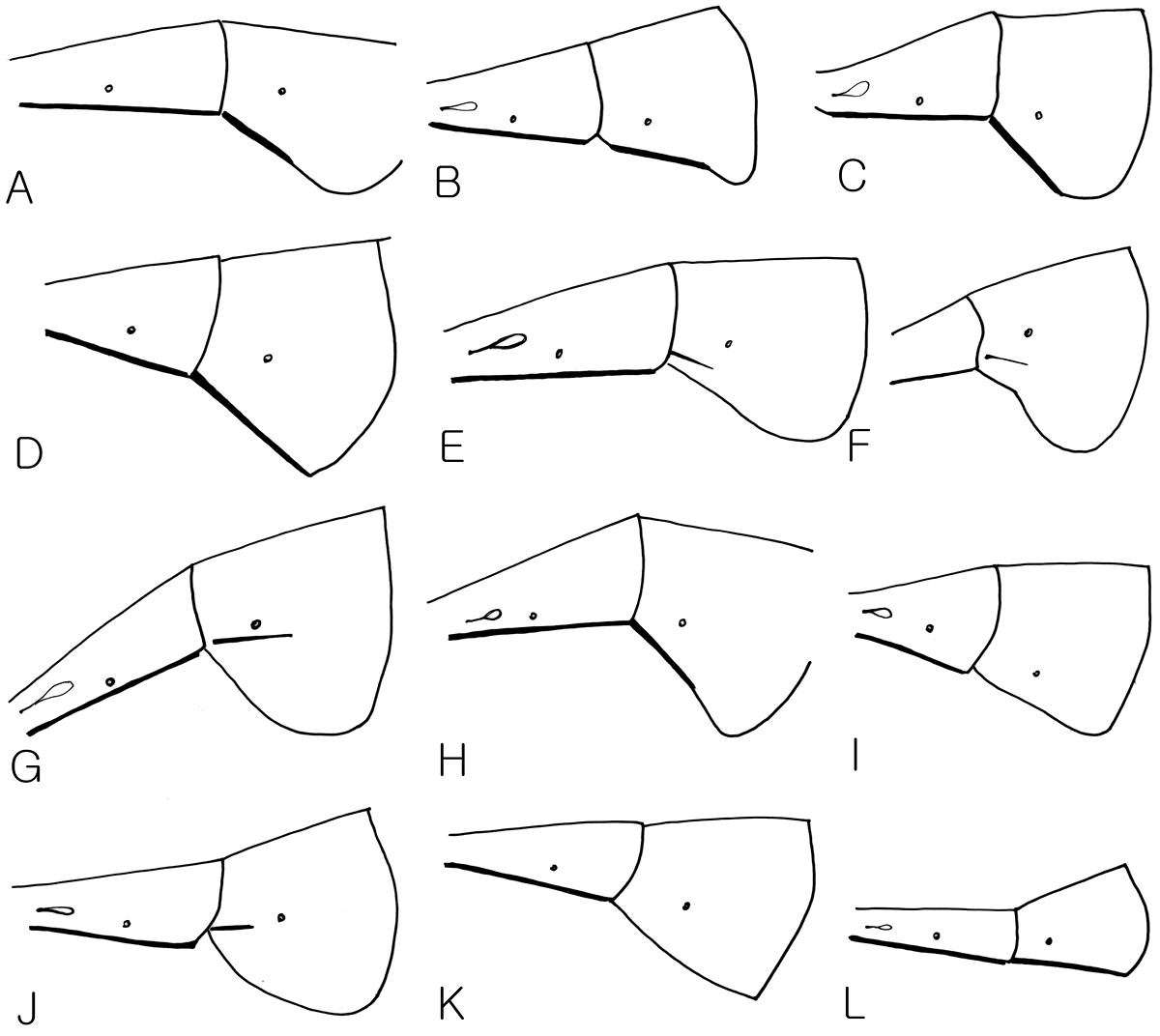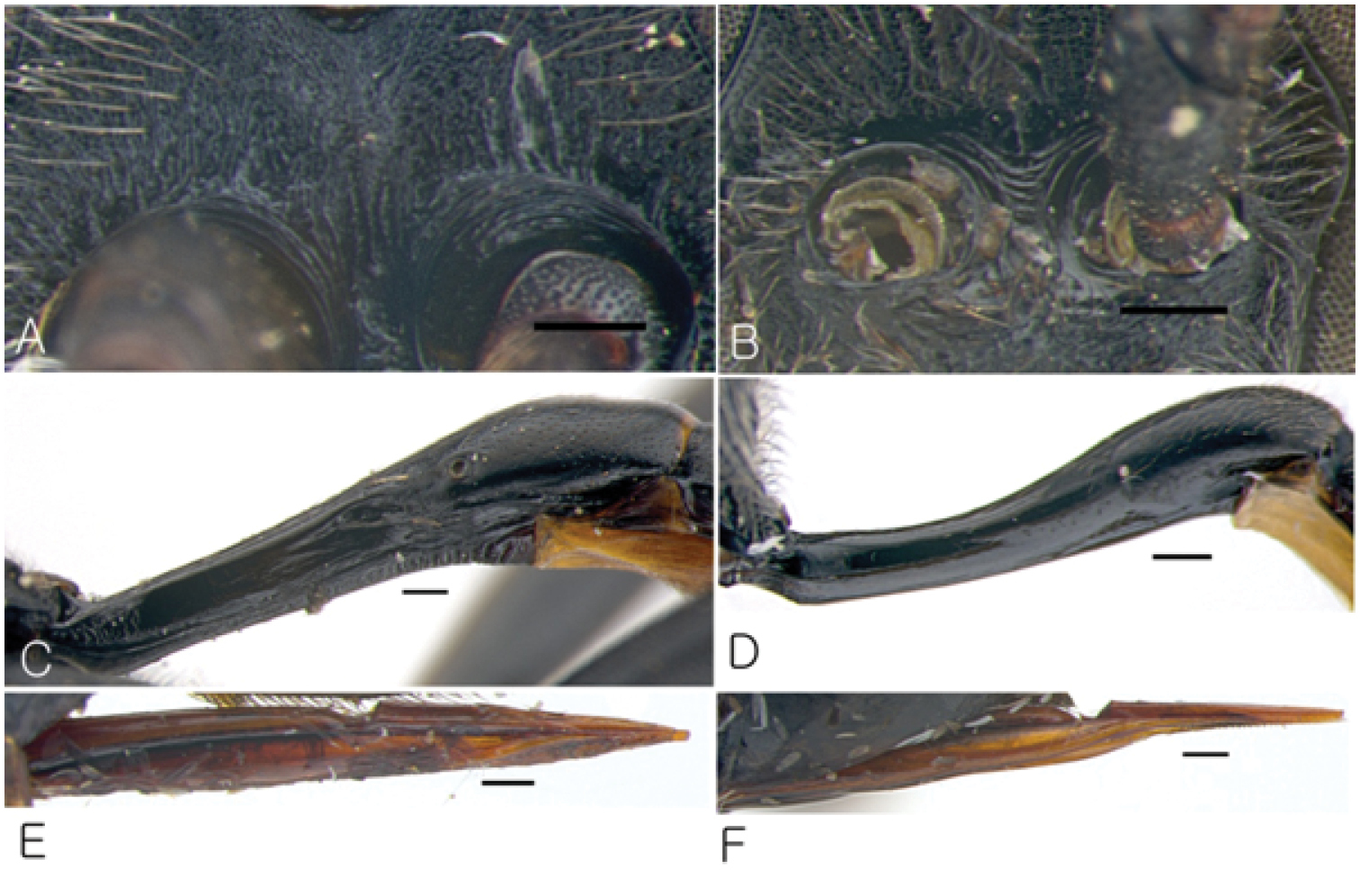






Citation: Choi J-K, Lee J-W (2014) Addition to the study of the genus Dusona (Hymenoptera, Ichneumonidae, Campopleginae) in Korea with description of a new species and key to the Korean species. ZooKeys 424: 59–89. doi: 10.3897/zookeys.424.7546
Korean species of the genus Dusona Cameron (Hymenoptera: Ichneumonidae: Campopleginae) are reviewed. Twenty seven species of Dusona are reported from South Korea, including 12 previously unrecorded species, D. bellipes (Holmgren, 1872), D. bicoloripes (Ashmead, 1906), D. chabarowski Hinz & Horstmann, 2004, D. cultrator (Gravenhorst, 1829), D. japonica (Cameron, 1906), D. mactatoides Hinz, 1994, D. scalprata Horstmann, 2004, D. sasayamae Hinz & Horstmann, 2004, D. oblitera (Holmgren, 1872), D. obtutor Hinz, 1994, D. auriculator Aubert, 1964, D. longicauda (Uchida, 1928), and a new species, D. koreana sp. n. An illustrated key to Korean species of Dusona provided.
Dusona koreana sp. n. , taxonomy
The subfamily Campopleginae includes more than 2, 000 valid species worldwide.
In this study a new species, Dusona koreana sp. n., is described. We also report 12 species new for the Korean fauna: Dusona bellipes (Holmgren, 1872), Dusona bicoloripes (Ashmead, 1906), Dusona chabarowski Hinz & Horstmann, 2004, Dusona cultrator (Gravenhorst, 1829), Dusona japonica (Cameron, 1906), Dusona mactatoides Hinz, 1994, Dusona scalprata Horstmann, 2004, Dusona sasayamae Hinz & Horstmann, 2004, Dusona obliterata (Holmgren, 1872), Dusona obtutor Hinz, 1994, Dusona auriculator Aubert, 1964 and Dusona longicauda (Uchida, 1928).
We also provide a description with photographs of the new species, comparative illustrations of all Korean species of Dusona, including habitus photographs, and an identification key to all Korean species.
Specimens used in this study were collected by sweeping and Malaise trapping, and are deposited in the animal systematic laboratory of Yeungnam University (YNU, Gyeongsan, Korea). Specimens were photographed using an AxioCam MRc5 camera attached to a stereo microscope (Zeiss SteREO Discovery. V20; Carl Zeiss, Göttingen, Germany), processed using AxioVision SE64 software (Carl Zeiss), and optimized with a Delta imaging system (i-solution, IMT i-Solution Inc. Vancouver, Canada). Some specimens examined in this study were loaned by the ZSM (Zoologisches Staatsammlung, München, Germany). The morphological terminology is mostly that of
Abbreviations are as follows. TD, type depository; TS, type species; CNC, Canadian National Collections, Centre for Land and Biological Resources Research, Agriculture Canada, Ottawa, Ontario, K1A 0C6, Canada; DEI, Deutsches Entomologisches Institut, Schicklerstrasse 5, D-16225; GUPTA, Entomology & Nematology Department, University of Florida, Gainesville, Florida, 32611, U.S.A.; HU, Hokkaido University, Faculty of Agriculture, Entomological Institute, Sapporo, Japan; MCZ, Museum of Comparative Zoology, Harvard University, Cambridge, Massachusetts, 02138, U.S.A.; MLSU, Zoological Museum, Moscow Lomonosov State University, Moscow, Russia; MRSN, Museo Regionale di Scienze Naturali, Via Giolitti 36, I-10123 Torino, Italy; MZ, Musée Zoologique, Place Riponne, CH-1000 Lausanne, Switzerland; NHM, The Natural History Museum, Department of Entomology, Cromwell Road, London, England, SW7 5BD, United Kingdom; NM, Naturwissenschaftliche Sammlungen der Stadt Krefeld, Brempter Hof, D-47829 Krefeld-Uerdingen, Germany; NR, Naturhistoriska Riksmuseet, Sektionen för Entomologi, S-104 05 Stockholm, Sweden; SAWON, Department of Forest Protection and Ecology, Warsaw Agricultural University, ul. Rakowiecka 26/30, 02-528 Warszawa, Poland; TMA, Termeszettudomanyi Muzeum Allattara, Barossa-Utea 13, Budapest H-1088, Hungary; USNM, National Museum of Natural History, Smithsonian Institute, Washington, D.C., 20560, U.S.A.; UZM, Universitets Zoologiske Museum, Universitetsparken 15, Copenhagen, Denmark; YU, Yale University, Peabody Museum, New Haven, Connecticut, 06511, U.S.A.; ZI, Zoological Institute, Academy of Sciences, St. Petersburg 199034, Russia; YNU, Animal systematic laboratory of Yeungnam University, Gyeongsan, Korea; ZSM, Zoologisches Staatsammlung, D 81247, München, Germany; GW, Gangwon-do; GG, Gyeonggi-do; GB, Gyeongsangbuk-do; GN, Gyeongsangnam-do; JB, Jeollabuk-do; JN, Jeollanam-do; JJ, Jeju-do.
Inner margin of eye with emargination opposite antenna socket; clypeus weakly convex, truncate or blunt; areola and petiolar areas of propodeum not separated by carina; propodeum with elongate spiracle; fore wing with large, usually rhombic areolet, pointed or stalked; discoidella reaching nervellus or detached; glymma of petiole present, vestigial or absent; epipleurum of 3rd tergum not separated by crease or sometimes partly separated; metasomal segments usually reddish brown and partly black or sometimes mostly black.
Worldwide.
| 1 | Epipleurum separated from the 3rd tergum, the crease with black line (Fig. 7D) | 2 |
| – | Epipleurum not separated from the 3rd tergum, with lateral black line above the anterior ventrolateral edge or without lateral black line (Figs 7J, 7K) | 13 |
| 2 | Ovipositor upcurved and longer than hind tibia (Fig. 3L) | Dusona longicauda |
| – | Ovipositor straight and shorter than hind tibia (Fig. 1A) | 3 |
| 3 | Antennal flagellum with less than 40 segments. 2nd recurrent vein of fore wing distad of the middle of areolet (Fig. 5D) | Dusona maruyamator |
| – | Antennal flagellum with more than 40 segments. 2nd recurrent vein of fore wing basad or opposite the middle of areolet (Figs 5B, 5C) | 4 |
| 4 | Areolet of fore wing pentagonal shape, without stalk (Fig. 5M) | Dusona bellipes |
| – | Areolet of fore wing quadrate, with or without stalk (Fig. 5R) | 5 |
| 5 | Antennal carina very highly raised, with wrinkles (Fig. 8A). Central part of face with weak protuberance (Fig. 4R) | Dusona mactatoides |
| – | Antennal carina not raised or low and narrow (Fig. 8B). Face convex generally (Fig. 4F) | 6 |
| 6 | Mandible brown to dark brown except basal part black (Fig. 4O) | 7 |
| – | Mandible completely or partly yellow (Fig. 4K) | 8 |
| 7 | Mandible dark brown (Fig. 4O). Tegula black. Nervellus vertical | Dusona chabarowski |
| – | Mandible brown (Fig. 4F). Tegula yellow. Nervellus inclivous | Dusona rugosa |
| 8 | Petiole in front of glymma smooth (Fig. 1F) | 9 |
| – | Petiole in front of glymma at least with fine sculpture or striate (Fig. 8C) | 11 |
| 9 | Antennal flagellum with less than 55 segments. Clypeus with rounded apical margin | Dusona stragifex |
| – | Antennal flagellum with more than 55 segments. Clypeus with truncate apical margin | 10 |
| 10 | Antennal carina distinctly raised, its rim bent upwards (Fig. 8A). Nervellus vertical, intercepted in lower 0.4. 4th tergum at least reddish brown anteriorly (Fig. 2B) | Dusona celator |
| – | Antennal carina low and narrow (Fig. 1C). Nervellus reclivous, intercepted in lower 0.25. Metasoma completely black posteriorly from 4th tergum black completely (Fig. 1A) | Dusona koreana Choi & Lee, sp. n. |
| 11 | Body length longer than 17 mm. Hind femur reddish brown, sometimes marked brown or black basally (Fig. 3D). Petiole with striate in front of glymma | Dusona cultrator |
| – | Body length shorter than 16 mm. Hind femur black (Fig. 3B). Petiole with fine sculpture in front of glymma (Fig. 8C) | 12 |
| 12 | Clypeus with truncate apical edge (Fig. 4N). 5th tergum reddish brown completely (Fig. 3B) | Dusona bicoloripes |
| – | Clypeus with concave apical edge (Fig. 4T). 5th tergum reddish brown narrowly marked with black dorsally (Fig. 3H) | Dusona sasayamae |
| 13 | Epipleurum not separated from the 3rd tergum, without anterior ventrolateral black stripe (Fig. 7K) | 14 |
| – | Epipleurum not separated from the 3rd tergum, however with distinct or weak black stripe anterior ventrolateral edge (Fig. 7J) | 19 |
| 14 | Antennal carina raised and the rim bent upward or widened (Fig. 8A) | 15 |
| – | Antennal carina low and narrow (Fig. 8B) | 17 |
| 15 | Clypeus with convex apical edge. Petiole without glymma (Fig. 8D). Nervellus reclivous and not intercepted | Dusona auriculator |
| – | Clypeus with truncate or weak concave apical edge. Petiole with distinct or large deep glymma (Fig. 8C). Nervellus inclivous and intercepted | 16 |
| 16 | Antennal flagellum with more than 65 segments. Frons with a median longitudinal carina. Mandible dark brown | Dusona matsumurae |
| – | Antennal flagellum with fewer than 65 segments. Frons without a median longitudinal carina. Mandible yellow | Dusona crassiventris |
| 17 | Clypeus with convex apical edge. Areolet of fore wing small, 2nd recurrent vein distad of its middle. Petiole without glymma (Fig. 5I). Body length shorter than 10 mm | Dusona schikotani |
| – | Clypeus with truncate apical edge. Areolet of fore wing large, 2nd recurrent vein basad of its middle. Petiole with glymma (Fig. 5G). Body length longer than 15 mm | 18 |
| 18 | Antennal flagellum with more than 65 segments. Frons without median longitudinal carina | Dusona falcator |
| – | Antennal flagellum with fewer than 60 segments. Frons with strong or weak a median longitudinal carina | Dusona obliterata |
| 19 | Petiole with distinct or weak glymma (Fig. 8C) | 20 |
| – | Petiole without glymma (Fig. 8D | 21 |
| 20 | Antennal carina low, the rim weakly bent upward. Frons with incomplete median longitudinal carina. Mandible yellow. Nervellus inclivous | Dusona glauca |
| – | Antennal carina weakly raised, the rim bent upward. Frons with very high raised median longitudinal carina. Mandible brown to black. Nervellus reclivous | Dusona ucrainica |
| 21 | 3rd tergum and 4th tergum black dorsally and widely reddish brown laterally | 22 |
| – | 3rd tergum reddish brown, 4th tergum reddish brown or black with reddish brown anteriorly | 23 |
| 22 | 2nd recurrent vein of fore wing connected to middle of areolet (Fig. 5J). Nervellus vertical. Tegula yellow | Dusona signator |
| – | 2nd recurrent vein of fore wing basad middle of areolet (Fig. 5S). Nervellus inclivous. Tegula blackish brown | Dusona scalprata |
| 23 | Antennal carina weakly raised, the rim weak bent upward. Hind femur reddish brown (Fig. 2A). Body length shorter than 10 mm | Dusona annexa |
| – | Antennal carina low and narrow or very strongly raised. Hind femur black. Body length longer than 10 mm (except body length of Dusona petiolator 8–10 mm) | 24 |
| 24 | Antennal flagellum with more than 56 segments. Antennal carina strongly raised. Clypeus with convex apical edge | Dusona okadai |
| – | Antennal flagellum with less than 52 segments. Antennal carina low and narrow. Clypeus with truncate apical edge | 25 |
| 25 | Frons with a median longitudinal carina. Nervellus reclivous. Petiole with longitudinal striae in front of glymma | Dusona obtutor |
| – | Frons without median longitudinal carina. Nervellus inclivous. Petiole smooth in front of glymma or with weak sculpture | 26 |
| 26 | Mandible black. Areolet large with short stalk. 2nd recurrent vein of fore wing basad middle of areolet (Fig. 5Q). 4th tergum reddish brown (Fig. 3E) | Dusona japonica |
| – | Mandible yellow. Areolet large without stalk. 2nd recurrent vein of fore wing distad middle of areolet. 4th tergum black or reddish brown anteriorly (Fig. 2E) | Dusona petiolator |
Dusona koreana Choi & Lee, sp. n. (female). A habitus in lateral view B head in frontal view C Frons D propodeum E mesosoma in lateral view F petiole in lateral view G wings H Ovipositor sheath. (Scale bar 2.0 mm for A, G; 0.5 mm for B, D–F; 0.2 mm for C, H).
General habitus in lateral view. A Dusona annexa (=Dusona americana) B Dusona celator C Dusona glauca D Dusona maruyamator E Dusona petiolator F Dusona rugosa G Dusona falcator H Dusona matsumurae I Dusona schikotani J Dusona signator K Dusona stragifex L Dusona ucrainica.
General habitus in lateral view. A Dusona bellipes B Dusona bicoloripes C Dusona chabarowski D Dusona cultrator E Dusona japonica F Dusona mactatoides G Dusona scalprata H Dusona sasayamae I Dusona obliterata J Dusona obtutor K Dusona auriculator L Dusona longicauda.
Head in frontal view. A Dusona annexa (=Dusona americana) B Dusona celator C Dusona glauca D Dusona maruyamator E Dusona petiolator F Dusona rugosa G Dusona falcator H Dusona matsumurae I Dusona schikotani J Dusona signator K Dusona stragifex L Dusona ucrainica M Dusona bellipes N Dusona bicoloripes O Dusona chabarowski P Dusona cultrator Q Dusona japonica R Dusona mactatoides S Dusona scalprata T Dusona sasayamae U Dusona obliterata V Dusona obtutor W Dusona auriculator X Dusona longicauda.
Areolet of fore wing. A Dusona annexa (=Dusona americana) B Dusona celator C Dusona glauca D Dusona maruyamator E Dusona petiolator F Dusona rugosa G Dusona falcator H Dusona matsumurae I Dusona schikotani J Dusona signator K Dusona stragifex L Dusona ucrainica M Dusona bellipes N Dusona bicoloripes O Dusona chabarowski P Dusona cultrator Q Dusona japonica R Dusona mactatoides S Dusona scalprata T Dusona sasayamae U Dusona obliterata V Dusona obtutor W Dusona auriculator X Dusona longicauda.
2nd and 3rd terga in lateral view. A Dusona annexa (=Dusona americana) B Dusona celator C Dusona glauca D Dusona maruyamator E Dusona petiolator F Dusona rugosa G Dusona falcator H Dusona matsumurae I Dusona schikotani J Dusona signator K Dusona stragifex L Dusona ucrainica.
2nd and 3rd terga in lateral view. A Dusona bellipes B Dusona bicoloripes C Dusona chabarowski D Dusona cultrator E Dusona japonica F Dusona mactatoides G Dusona scalprata H Dusona sasayamae I Dusona obliterata J Dusona obtutor K Dusona auriculator L Dusona longicauda.
Characters of Korean Dusona. A Antennal carina highly raised, rim bent upwards and with striae (Dusona mactatoides) B Antennal carina low and narrow, without striae (Dusona chabarowski) C Petiole with fine sculpture in front of strong glymma (Dusona bicoloripes) D Petiole without glymma (Dusona auriculator) E Lower valve of ovipositor straight (Dusona koreana) F Lower valve of ovipositor sinuous (Dusona cultrator). (Scale bar 0.2 mm).
Female. Body length 16.5 mm. Fore wing 13.0 mm.
Color: Face and mesosoma black (Fig. 1B, E). Mandible yellow except black basally (Fig. 1B). Tegula blackish brown. All coxae black except fore coxa yellowish brown apically; fore trochanter to tarsus yellowish brown; mid trochanter and trochantellus black, mid femur to tarsus yellowish brown; hind trochanter to femur black, hind tibia yellowish brown marked dark brown apically. 2nd tergum on apical 0.25, 3rd tergum reddish brown broadly. Ovipositor reddish brown, ovipositor sheath black with brown apically.
Head: Frons slightly depressed, with median longitudinal carina, with transverse wrinkles (Fig. 1C). Antennal flagellum with 61 segments. Antennal carina low and narrow, above with radial wrinkles. Face convex, densely punctate. Clypeus separated from face by weak groove, with truncated apical margin. Mandible tapered to apex, lower tooth as long as upper tooth. Malar space 0.5 times as long as width of mandible. Occipital carina complete. Temple weakly convex.
Mesosoma: Pronotum with distinct epomia. Mesoscutum without notaulus. Speculum depressed and flat, mesopleuron in front of speculum with short longitudinal striae (Fig. 1E). Scutellum and postscutellum convex, scutellum without lateral carina. Propodeal spiracle elongate, distinctly connected to pleural carina. Propodeum depressed, with rugose wrinkles; anterior transverse carina of propodeum present medially, costula absent (Fig. 1D). First radius of fore wing originating before middle of pterostigma. Areolet large, with short stalk (Fig. 1G), 2nd recurrent vein originating before middle of areolet. Nervellus reclivous, intercepted in lower 0.25, discoidella faint (Fig. 1G). Hind wing with 9 distal hamuli. Tibiae and tarsi with short strong spines; tarsal claws pectinate.
Metasoma: Petiole with very strong glymma, dorsolateral carina very strong (Fig. 1F). Epipleurum separated from 3rd tergum, crease with distinct black line. 1st tergum 4.3 times as long as wide, 2nd tergum 1.6 times as long as wide. Ovipositor straight, shorter than hind tibia and longer than hind basitarsus. Ovipositor sheath wide and aciculate basally in lateral view (Fig. 1H).
Male. unknown.
(only differences from holotype described) Antennal flagellum with 56–62 segments.
Holotype: [Korea] TD: YNU. 1 female, GW, Wonju-si, Panbu-myeon, Seogok-ri, Yongsugol, 19 May 2001, J.W. Lee & D.C. Kim. Paratype: [Korea] TD: YNU. 1 female, Seoul, Gangnam-gu, Wonji-dong, 1 June 1985, K.H. Shin; 1 female, GG, Cheonmasan, 7 June 1986, P.C. Yun; 1 female, GG, Seongnam-si, Namhansan, 23 May 1999, E.J. Kim. Non-Type: [Korea] TD: YNU. 1 female, 24 May 1986, S.Y. Park.
Korea.
Eastern Palaearctic.
Unknown.
The specific name is derived from Korea, the country of the type specimens.
The species is similar to Dusona cultrator (Gravenhorst, 1829) but differs by in the following characters: lower valve of ovipositor straight (Fig. 8E) (lower valve sinuous in Dusona cultrator) (Fig. 8F), hind tibia yellowish brown marked dark brown apically (hind tibia yellowish brown, sometimes narrowly marked with brown basally in Dusona cultrator); petiole with very large glymma (Fig. 1F), which is bordered by very distinct longitudinal carina dorsally; 1st tergum longer than 4 times as long as wide (1st tergum 3.4 times as long as wide in Dusona cultrator). Also, the metasomal segments of Dusona are usually reddish brown and partly black but the metasoma of Dusona koreana is mostly black with only the 2nd tergum reddish brown apically and 3rd tergum widely reddish brown laterally (Fig. 1A).
[Korea]: 1 female, Seoul, Cheonggyesan, 28 May 1989, G.G. Lee.
Female. Body length 16.0 mm.
Color: Face and mesosoma black. Mandible yellow except basal part black. Tegula blackish brown. All coxae black; fore and mid legs yellowish brown except trochanter to femur dark brown ventrally; hind femur black, hind tibia to tarsus dark brown. 2nd tergum on 0.25 apically to 5th tergum reddish brown broadly. Ovipositor reddish brown and ovipositor sheath black except brown apically.
Head: Frons slightly depressed, with fine punctures and with a median longitudinal carina. Antennal flagellum with 57 segments. Antennal carina low and narrow; frons above antennal carina polished. Face moderately convex, densely punctated (Fig. 4M). Clypeus not separated from face, with truncate apical edge. Mandible tapered to apex, lower tooth as long as upper tooth. Malar space much shorter than half of basal width of mandible.
Mesosoma: First radius of fore wing originated before middle of pterostigma. Areolet large (Fig. 5M), 2nd recurrent vein connected before middle of areolet. Nervellus inclivous, intercepted in lower 0.3, discoidella faint. Hind wing with 8 distal hamuli. Propodeum without areola but basal transverse carina distinct, costula absent.
Metasoma: Epipleurum separated from the 3rd tergum, the crease marked with black line (Fig. 7A). 1st tergum 5.1 times as long as wide, 2nd tergum 2.4 times as long as wide. Ovipositor straight and shorter than hind tibia.
Korea (new record), Austria, Belarus, France, Germany, Italy, Japan, Latvia, Netherlands, Poland, Romania, Russia (Saratov), Sweden, Switzerland and United Kingdom.
Eastern Palaearctic, Western Palaearctic.
Unknown.
[Korea]: 1 female, Seoul, Seocho-gu, Cheonggyesan, 21 May 2002, H.J. Lim.
Female. Body length 15.5 mm.
Color: Face and mesosoma black. Mandible yellow except basal part black. Tegula black. All coxae black; fore and mid legs brown to dark brown; hind femur black, tibia to tarsus dark brown. 2nd tergum on 0.25 apically to 5th tergum reddish brown, except upper part of half of 5th tergum broadly black. Ovipositor reddish brown and ovipositor sheath black except brown apically.
Head: Frons slightly depressed, with fine punctures and with weak median longitudinal carina. Antennal flagellum with 55 segments. Antennal carina low and narrow, without wrinkles. Face moderately convex, densely punctated (Fig. 4N). Clypeus not separated from face, with truncate apical edge. Mandible tapered to apex, lower tooth as long as upper tooth. Malar space shorter than half of basal width of mandible.
Mesosoma: First radius of fore wing originated from middle of pterostigma. Areolet with long stalk, 2nd recurrent vein connected before middle of areolet (Fig. 5N). Nervellus vertical or reclivous, intercepted in lower 0.3, discoidella faint. Hind wing with 8 distal hamuli. Propodeum without areola but basal transverse carina distinct, costula absent.
Metasoma: Epipleurum separated from the 3rd tergum, the crease marked with black line (Fig. 7B). 1st tergum 3.6 times as long as wide, 2nd tergum 1.8 times as long as wide. Ovipositor straight and shorter than hind tibia.
Korea (new record), Algeria, Armenia, Austria, Azerbaijan, Belarus, Belgium, Bulgaria, Croatia, Czech Republic, late Czechoslovakia, Finland, France, Georgia, Germany, Greece, Ireland, Italy, Japan, Kazakhstan, Kyrgyzstan, Moldova, Netherlands, Norway, Poland, Romania, Russia (Kabarovsk, Krasnodar, Primor’ye, Sakhalin, Sankt Petersburg, Yevreyskaya), Slovakia, Slovenia, Spain, Switzerland, Turkey, Ukraine and United Kingdom.
Eastern Palaearctic, Western Palaearctic.
Unknown.
[Korea]: 1 female, Seoul, Nowon-gu, Suraksan, 15 May 1997, J.Y. Kim; 1 female, Seoul, Hwagyesan, 6 May 1989, J.H. Hwang; 1 female, GG Anyang-si, Anyang Arboretum, 13 May 1995, T.H. Gu; 1 female, GW Chuncheon-si, Bongraesan, 13 June 1981, S.H. Kim; 1 female, GW Sockcho-si, Seolaksan National Park, 18 May 2002, M.H. Kim.
Female. Body length 10.0-13.0 mm.
Color: Face and mesosoma black. Mandible dark brown except ventrobasal part black. Tegula blackish brown. All coxae black; fore leg dark reddish brown; mid leg dark brown except tibia brown; hind leg black. 2nd tergum on 0.3 apically to 4th tergum reddish brown. Ovipositor reddish brown and ovipositor sheath black and brown apically.
Head: Frons slightly depressed, with median longitudinal carina. Antennal flagellum with 47-53 segments. Antennal carina low and narrow. Face moderately convex, densely punctated. Clypeus not separated from face, with truncate apical edge (Fig. 4O). Mandible tapered to apex, lower tooth as long as upper tooth. Malar space as long as half of basal width of mandible.
Mesosoma: First radius of fore wing originated before middle of pterostigma. Areolet with long stalk (Fig. 5O), 2nd recurrent vein begin before middle of areolet. Nervellus almost vertical or inclivous, intercepted in lower 0.5, discoidella absent. Hind wing with 8 distal hamuli. Propodeum without areola, costula absent.
Metasoma: Epipleurum separated from the 3rd tergum, the crease with black line (Fig. 7C). 1st tergum 3.1 times as long as wide, 2nd tergum 1.7 times as long as wide. Ovipositor straight and shorter than hind basitarsus.
Korea (new record) and Russia (Khabarovsk, Primo’ye).
Eastern Palaearctic.
Unknown.
[Korea]: 1 female, Seoul, Dobong-gu, Bukhansan National Park, 24 April 1999, T.H. Kim.
Female. Body length 17.5 mm.
Color: Face and mesosoma black. Mandible yellow. Tegula blackish brown. All coxae black; fore leg yellowish brown; mid trochanter and trochantellus black, mid femur brown; hind leg black except tibia brown. 2nd tergum on 0.3 apically to 3rd tergum reddish brown completely. Ovipositor reddish brown.
Head: Frons slightly depressed, with median longitudinal carina. Antennal flagellum all missing. Antennal carina low and narrow; antennal carina above with radial wrinkles. Face moderately convex, densely punctated. Clypeus not separated from face, with truncate apical margin (Fig. 4P). Mandible tapered to apex, lower tooth as long as upper tooth. Malar space shorter than half of basal width of mandible.
Mesosoma: First radius of fore wing originated before middle of pterostigma. Areolet large (Fig. 5P), with short stalk, 2nd recurrent vein begin before middle of areolet. Nervellus vertical, intercepted in lower 0.3, discoidella faint. Hind wing with 10 distal hamuli. Propodeum without areola, costula incomplete.
Metasoma: Epipleurum separated from the 3rd tergum, the crease with black line (Fig. 7D). 1st tergum 3.4 times as long as wide, 2nd tergum 1.2 times as long as wide. Lower valve of ovipositor winding, ovipositor shorter than hind tibia.
Korea (new record), Algeria, Austria, Belarus, Belgium, Bulgaria, Czech Republic, late Czechoslovakia, Finland, France, Germany, Greece, Hungary, Italy, Japan, Kazakhstan, Kyrgyzstan, Latvia, Moldova, Morocco, Netherlands, Poland, Romania, Russia (Chita, Irkutsk, Khabarovsk, Primor’ye, Samarskaya, Sankt Petersburg, Tomsk, Yaroslavl), Slovakia, Spain, Sweden, Switzerland, Tunisia, Turkey, Ukraine and United Kingdom.
Eastern Palaearctic, Western Palaearctic.
Lepidoptera. Noctuidae: Orthosia stabilis (Denis & Schiffermüller, 1775).
[Korea]: 1 female, Seoul, Nowon-gu, Hagye1-dong, 25 April 1998, H.J. Yun; 2 females, GB Gyeongsan-si, Dae-dong, Yeungnam univ., 22-29 April 2008, J.W. Lee; 1 female, JN Yeongkwang-gun, Yeomsan-myeon, Bongnam-ri, 23 April 2009, J.K. Choi & D.H. Lee.
Female. Body length 11.0-12.0 mm.
Color: Face and mesosoma black. Mandible dark brown to black. Tegula black. All legs black; fore femur and tibia with yellow spots on anterior part. 3rd tergum and 4th tergum reddish brown, basal part of 5th tergum reddish brown. Ovipositor reddish brown to dark brown and ovipositor sheath black.
Head: Frons not depressed, without median longitudinal carina. Antennal flagellum with 48-52 segments. Antennal carina low and narrow. Face moderately convex, densely punctated. Clypeus a little separated from face by weak groove, with truncate apical margin (Fig. 4Q). Mandible tapered to apex, lower tooth as long as upper tooth. Malar space longer than half of basal width of mandible.
Mesosoma: First radius of fore wing originated from middle of pterostigma. Areolet with short stalk, 2nd recurrent vein begin before middle of areolet (Fig. 5Q). Nervellus inclivous, intercepted in lower 0.1, discoidella absent. Hind wing with 6 distal hamuli. Propodeum without areola, costula absent.
Metasoma: Epipleurum not separated from the 3rd tergum, with lateral black line above the ventrolateral edge (Fig. 7E). 1st tergum 4.6 times as long as wide, 2nd tergum 1.9 times as long as wide. Ovipositor shorter than hind basitarsus.
Korea (new record), China, India, Japan, Kazakhstan, Kyrgyzstan, Russia (Irkutsk, Sakhalin) and Uzbekistan.
Eastern Palaearctic, Oriental.
Unknown.
[Korea]: 1 female, GG Hanam-si, Namhansanseong, 31 July 1993, J.S. Lee.
Female. Body length 17.5 mm.
Color: Face and mesosoma black. Mandible brown except ventrobasal part dark brown. Tegula blackish brown. All coxae black; fore leg yellowish brown; mid femur borwn to blackish brown, mid tibia yellowish brown, mid tarsi dark brown; hind leg black except tibia brown and black apically. 2nd tergum on ventro-apical part reddish brown; 3rd tergum to 7th tergum dark reddish brown. Ovipositor sheath black.
Head: Frons and surface between the antennal sockets deeply depressed, with median longitudinal carina. Antennal flagellum with 64 segments. Antennal carina strongly raised, the rim bend upwards and with transverse striae; antennal carina above with long radial wrinkles. Face moderately convex, densely punctated. Central part of face with weak protuberance (Fig. 4R). Clypeus weakly convex and a little separated from face by a weak groove, with truncate apical margin. Mandible tapered to apex, lower tooth as long as upper tooth. Malar space shorter than half basal width of mandible.
Mesosoma: First radius of fore wing originated from middle of pterostigma. Areolet with stalk, 2nd recurrent vein begin before middle of areolet (Fig. 5R). Nervellus reclivous, intercepted in lower 0.3, discoidella faint. Hind wing with 8 distal hamuli. Propodeum without areola, costula incomplete.
Metasoma: Epipleurum separated from the 3rd tergum, but the crease without black line, but with lateral black line above the anterior ventrolateral edge (Fig. 7F). 1st tergum 4.3 times as long as wide, 2nd tergum 2.2 times as long as wide. Ovipositor shorter than hind basitarsus.
Korea (new record) and Russia (Sakhalin).
Eastern Palaearctic.
Unknown.
[Korea]: 1 male, Seoul, Gangnam-gu, Suseo-dong, Guryongsan, 27 May 1998, J.E. Kim.
Male. Body length 15.5 mm.
Color: Face and mesosoma black. Mandible yellow except basal part black. Tegula blackish brown. Fore and mid legs yellowish brown except coxae black; hind coxa to femur black except apical part of femur yellowish brown, hind tibia and tarsus yellowish brown. 2nd tergum on ventro-apical to 7th tergum reddish brown; 2nd tergum broadly black dorsally, 3rd to 7th terga with narrow black line dorsally. Clasper of male reddish brown.
Head: Frons slightly depressed, with fine punctures and with median longitudinal carina. Antennal flagellum with 53+ segments, apical flagellomeres missing. Antennal carina low and narrow. Face moderately convex, densely punctated, with white hairs (Fig. 4S). Clypeus a little separated from face by weak groove, with truncate apical margin. Mandible tapered to apex, lower tooth a little shorter than upper tooth. Malar space as long as half of basal width of mandible.
Mesosoma: First radius of fore wing originated from middle of pterostigma. Areolet without stalk, 2nd recurrent vein begin before middle of areolet (Fig. 5S). Nervellus inclivous, intercepted in lower 0.25, discoidella absent. Hind wing with 8 distal hamuli. Propodeum without areola but basal transverse carina distinct.
Metasoma: Epipleurum not separated from the 3rd tergum, with indistinct lateral black line above the anterior ventrolateral edge (Fig. 7G). 1st tergum 4.4 times as long as wide, 2nd tergum 4.6 times as long as wide.
Korea (new record) and Russia (Primor’ye).
Eastern Palaearctic.
Unknown.
[Korea]: 2 females, Daejeon-si, Dong-gu, Daejeon univ., 16 May–5 June 2006, J.W. Lee.
Female. Body length 12.0–16.0 mm.
Color: Face and mesosoma black. Mandible yellow. Tegula blackish brown. All coxae black; fore leg yellowish brown except outer areas of trochanter and inner areas of trochantellus blackish brown; mid leg blackish brown except part of femur and tibia brown; hind leg black except tibia brown. 2nd tergum to 4th tergum reddish brown, 5th tergum reddish brown except black dorsally, 6th tergum black except reddish brown ventrally. Ovipositor reddish brown and ovipositor sheath black and reddish brown apically.
Head: Frons slightly depressed, with fine punctures and with median longitudinal carina. Antennal flagellum with 55 segments. Antennal carina low and narrow. Face moderately convex, densely punctated. Clypeus not separated from face, with concaved apical edge (Fig. 4T). Mandible tapered to apex, lower tooth shorter than upper tooth. Malar space shorter than half basal width of mandible.
Mesosoma: First radius of fore wing originated from middle of pterostigma. Areolet with stalk (Fig. 5T), 2nd recurrent vein begin a little before middle of areolet. Nervellus almost vertical, intercepted in lower 0.25, discoidella faint. Hind wing with 8 distal hamuli. Propodeum without areola, costula absent.
Metasoma: Epipleurum separated from the 3rd tergum, the crease marked with black line (Fig. 7H). 1st tergum 3.5 times as long as wide, 2nd tergum 1.8 times as long as wide. Ovipositor straight and shorter than hind basitarsus.
Korea (new record) and Japan.
Eastern Palaearctic.
Unknown.
[Korea]: 1 female, GG Paju-si, Jeokseong-myeon, Seolma-ri, 18 August 1984, M.I. Lee.
Female. Body length 16.0 mm.
Color: Face and mesosoma black. Mandible yellow. Tegula blackish brown. All coxae black; fore and mid legs yellowish brown; hind leg blackish brown except tibia yellowish brown. 2nd tergum on ventro-apical edge to basal of 5th tergum reddish brown.
Head: Frons slightly depressed, with fine punctures and with partly obliterated median longitudinal carina. Antennal flagellum with 58 segments. Antennal carina low, the rim weak bent upwards and with radial wrinkles. Face moderately convex, densely punctated. Central part of face with weak protuberance (Fig. 4U). Clypeus not separated from face, with truncate apical edge. Mandible tapered to apex, lower tooth as long as upper tooth. Malar space shorter than half basal width of mandible.
Mesosoma: First radius of fore wing originated from middle of pterostigma. Areolet large without stalk, 2nd recurrent vein begin a little before middle of areolet (Fig. 5U). Nervellus vertical, intercepted in lower 0.3, discoidella faint. Hind wing with 9 distal hamuli. Propodeum without areola but basal transverse carina distinct.
Metasoma: Epipleurum not separated from the 3rd tergum, without black line (Fig. 7I). 1st tergum 4.6 times as long as wide, 2nd tergum 2.0 times as long as wide. Ovipositor straight and shorter than hind basitarsus.
Korea (new record), Austria, Belarus, Belgium, Bulgaria, Croatia, Czech Republic, late Czechoslovakia, Finland, France, Germany, Hungary, Italy, Latvia, Moldova, Netherlands, Poland, Romania, Russia (Irkutsk, Moscow, Primor’ye, Sankt Petersburg, Smolensk), Spain, Sweden, Switzerland, Turkey and United Kingdom.
Eastern Palaearctic, Western Palaearctic.
Lepidoptera. Noctuidae: Acronicta leporina (Linnaeus, 1758); Notodontidae: Euchila palpina (Clerck, 1759); Thyatridae: Achlya flavicornis (Linnaeus, 1758).
[Korea]: 1 female, JB Jeongeup-si, Naejang-dong, Naejangsan National Park, Ansambatsil, 18 May 2004, J.G. Han.
Female. Body length 11.0 mm.
Color: Face and mesosoma black. Mandible yellow except basal part black. Tegula blackish brown. All coxae to trochentellus black; fore femur yellowish brown to dark brown, from fore tibia yellow; middle leg blackish brown except tibia brown; hind leg black. 2nd tergum on ventroapical edge to 3rd tergum reddish brown. Ovipositor reddish brown and ovipositor sheath black.
Head: Frons slightly depressed, with fine punctures and with median longitudinal carina. Antennal flagellum with 43 segments. Antennal carina low and narrow. Face moderately convex, densely punctated (Fig. 4V). Clypeus not separated from face, with truncate apical edge. Mandible tapered to apex, lower tooth shorter than upper tooth. Malar space longer than half basal width of mandible.
Mesosoma: First radius of fore wing originated from middle of pterostigma. Areolet small with long stalk (Fig. 5V), 2nd recurrent vein begin after middle of areolet. Nervellus reclivous, intercepted in lower 0.25, discoidella absent. Hind wing with 7 distal hamuli. Propodeum without areola, basal transverse carina incomplete.
Metasoma: Epipleurum not separated from the 3rd tergum, with distinct lateral black line above the anterior ventrolateral edge (Fig. 7J). 1st tergum 4.4 times as long as wide, 2nd tergum 2.1 times as long as wide. Ovipositor straight, shorter than hind basitarsus.
Korea (new record) and Japan.
Eastern Palaearctic.
Unknown.
[Korea]: 1 male, GW Wongju-si, Socho-myeon, Hakgong-ri, Chiaksan National Park, 28 August-16 September 2013, J.W. Lee.
Male. Body length 8.5 mm.
Color: Face and mesosoma black. Mandible and tegula yellow. Fore leg yellow except fore coxa black basally; middle leg yellow except coxa black dorsally; hind coxa black; hind trochanter to tibia brown, femur and tibia black apically; hind tarsus darker than hind femur. 2nd tergum reddish brown on ventroapical edge; 3rd tergum to 7th tergum reddish brown, with narrow black line dorsally. Clasper of male yellowish brown.
Head: Frons slightly depressed, with fine punctures and with median longitudinal carina. Antennal flagellum with 46 segments. Antennal carina strongly raised, the rim widened to a smooth bulge. Face moderately convex, densely punctated. Clypeus not separated from face, with round apical edge (Fig. 4W). Mandible tapered to apex, lower tooth as long as upper tooth. Malar space as long as half basal width of mandible.
Mesosoma: Pronotum and speculum of mesosoma polished. First radius of fore wing originated weakly before middle of pterostigma. Areolet small with long stalk, 2nd recurrent vein distad of middle of areolet (Fig. 5W). Nervellus reclivous, not intercepted or weak, discoidella absent. Hind wing with 5 distal hamuli. Propodeum without areola but basal transverse carina distinct.
Metasoma: Epipleurum not separated from the 3rd tergum, without lateral black line (Fig. 7K). 1st tergum 4.8 times as long as wide, 2nd tergum 2.9 times as long as wide.
Korea (new record), Austria, Bulgaria, France, Greece, Italy, Japan, Romania and Russia (Khabarovsk, Primor’ye).
Eastern Palaearctic, Western Palaearctic.
Unknown.
[Korea]: 1 female, Seoul, Gangnam-gu, Cheonggyesan, 6 September 1986, Y.H. Lee; 2 females, GG Su-dong, Chukryeongsan, 28 September 1980, H.K. Park; 1 female, GW Sokcho-si, Seorak-dong, 11 June 1992, J.W. Lee; 1 female, GB Gyeongsan-si, Dae-dong, Yeungnam univ., 17 May 1989, Y.K. Lee; 1 female, ditto, 30 May 1989, J.W. Lee; 1 female, ditto, 21-27 May 2008, J.W. Lee; 9 females, GB Eulseong-gun Ansa-myeon, Ansamyeonsamuso, 1 April-1 May 2013, S.J. Park; 1 female, GB Cheongdo-gun, Gakbuk-myeon, Namsan 3-ri, 2-15 June 2008, J.W. Lee; 2 females, GN Jinju-si, Gajwa-dong, 18-24 May 1990, J.W. Lee; 1 female, ditto, 27 May 1991, J.W. Lee; 1 female, ditto, 29 May 1991, J.W. Lee; 1 female, ditto, 1-9 June 1990, J.W. Lee; 1 female, GN Haman-gun, Daesan-myeon, 22 April 1991, J.W. Lee; 1 female, JN Wando-gun Soan-myeon, Soan-do, 15 May-11 June 2011, J.W. Lee; 1 female, JJ Jeju-si, Aewol-eup, Gwangnyeong-ri, Sumeunmulbaengdwi, weltland of 1, 100Goji, 24 August 2010, H.S. Lee; 1 female, JJ Seogeypo-si, Cheongsonyeonyayeongjang, 21 May 2003, J.W. Lee.
Female. Body length 10.0–13.0 mm.
Color: Face and mesosoma black. Mandible yellow except basal part black. Tegula blackish brown. All coxae to trochentellus black; fore leg yellowish brown except femur ventrally dark brown; middle leg blackish brown except tibia yellowish brown; hind leg blackish brown. 2nd tergum on 0.25 apically to 4th tergum reddish brown. Ovipositor reddish brown and ovipositor sheath black.
Head: Frons slightly depressed, with fine punctures and with median longitudinal carina. Antennal flagellum with 41-45 segments. Antennal carina low and narrow. Face moderately convex, densely punctated (Fig. 4X). Clypeus not separated from face, with round apical edge. Mandible tapered to apex, lower tooth as long as upper tooth. Malar space as long as half basal width of mandible.
Mesosoma: First radius of fore wing originated weakly before middle of pterostigma. Areolet large, without stalk (Fig. 5X), 2nd recurrent vein begin a little before middle of areolet. Nervellus inclivous, intercepted in lower 0.5, discoidella faint. Hind wing with 6-7 distal hamuli. Propodeum without areola but basal transverse carina distinct.
Metasoma: Epipleurum separated from the 3rd tergum, the crease marked with black line (Fig. 7L). 1st tergum 5.2 times as long as wide, 2nd tergum 2.4 times as long as wide. Ovipositor upcurved, longer than hind tibia.
Korea (new record), China, Japan and Russia (Khabarovsk, Krasnoyarsk, Primor’ye, Sakhalin).
Eastern Palaearctic, Oriental.
Unknown.
[Korea]: No specimens; [Germany]: 1 female, 17 July 1956, Zwiesel B.W.
Korea, Austria, Belarus, Belgium, Bulgaria, Canada, China, Czech Republic, late Czechoslovakia, Finland, France, Georgia, Germany, Hungary, Ireland, Italy, Japan, Kazakhstan, Moldova, Mongolia, Netherlands, Norway, Poland, Romania, Russia (Amur, Buryatskaya Respublika, Chita, Kamchatka, Khabarovsk, Murmansk, Primor’ye, Sakhalin, Sankt Petersburg, Yevreyskaya), Slovakia, Sweden, Switzerland, Turkey, U.S.A., Ukraine and United Kingdom.
Eastern Palaearctic, Western Palaearctic, Nearctic.
Unknown.
No Korean specimens were available for this study. However we have seen a voucher specimen from ZSM.
[Korea]: No specimens; [TD: ZSM]: 1 female.
Korea and Russia (Chita, Primor’ye).
Eastern Palaearctic.
Unknown.
No Korean specimens were available for this study. However we have seen a Russian voucher specimen from ZSM. The tip of the fore coxa of male is yellowish red, whereas in other characters it is similar to the female.
[Korea]: No specimens.
Korea.
Eastern Palaearctic.
Unknown.
This species was recorded from Korea as an endemic species by Horstmann (2004). However no Korean specimens were available for this study.
[Korea]: 1 male, GW Donghae-si, Samhwa-dong, Muryeong valley, 16–28 June 2005, J.W. Lee; 1 female, JN Jeongeup-si Ibam-myeon, Deungcheon-ri, 23 July 2004, J.G. Han.
Korea, Austria, Azerbaijan, Belgium, Bulgaria, Czech Republic, late Czechoslovakia, Finland, France, Germany, Hungary, Ireland, Israel, Italy, Kazakhstan, Netherlands, Norway, Poland, Romania, Russia (Altayskiy, Kirov, Primor’ye, Samarskaya, Sankt Petersburg), Sweden, Switzerland, Turkey, Ukraine and United Kingdom.
Eastern Palaearctic, Western Palaearctic.
Unknown.
[Korea]: No specimens; [TD: ZSM]: 1 male.
Korea, Canada, Japan, Russia (Chita, Irkutsk, Khabarovsk, Magadanskaya, Primor’ye, Sakhalin) and U.S.A.
Eastern Palaearctic, Nearctic.
Unknown.
No Korean specimens were available for this study. However we have seen a Japanese voucher specimen from ZSM.
[Korea]: 4 females, Daejeon-si, Daejeon univ., 1-17 May 2006, J.K Choi; 1 female, GB Gyeongsan-si, Dae-dong, Yeungnam univ., 22 April-1 May 2006, J.W. Lee; 1 female, JB Jeongeup-si, Naejang-dong, Wonjeogam, 28 April-28 May 2006, J.K Choi.
Korea, Japan and Russia (Khabarovsk, Primor’ye, Sakhalin).
Eastern Palaearctic.
Unknown.
[Korea]: 1 female, GG Gapyeung-gun, Seorak-myeon, 14 June 1992, J.W. Lee; 1 female, 1 male, GN Gayasan, 5 August 1960, C.H. Kim.
Korea, Japan and Russia (Amur, Primor’ye).
Eastern Palaearctic.
Unknown.
[Korea]: No specimens; Holotype: 1 female.
Korea, China and Russia (Primor’ye, Yevreyskaya).
Eastern Palaearctic.
Unknown.
No Korean specimens were available for this study. However we have seen a voucher specimen from ZSM and have loaned holotype from HU.
[Korea]: 1 female, 1male, Daejeon-si, Daejeon univ., 16 May–5 June 2006, J.W. Lee; 1 male, ditto, 1-17 May 2006, J.W. Lee.
Korea, Austria, Belarus, Belgium, Canada, Czech Republic, late Czechoslovakia, Denmark, Finland, France, Germany, India, Ireland, Italy, Japan, Kyrgyzstan, Latvia, Netherlands, Norway, Pakistan, Poland, Romania, Russia (Altayskiy, Amur, Chita, Irkutsk, Kamchatka, Khabarovsk, Murmansk, Novosibirsk, Orenburg, Sakhalin, Sankt Petersburg, Vologda, Yaroslavl), Sri Lanka, Sweden, Turkey, U.S.A. and United Kingdom.
Eastern Palaearctic, Western Palaearctic, Nearctic, Oriental.
Lepidoptera. Geometridae: Philereme transversata (Hufnagel, 1767), Philereme vetulata (Denis & Schiffermüller, 1775), Rheumaptera cervinalis (Scopoli, 1763), Rheumaptera hastata (Linnaeus, 1758), Rheumaptera undulata (Linnaeus, 1758).
[Korea]: No specimens; Holotype: 1 female.
Korea and Japan.
Eastern Palaearctic.
Unknown.
No Korean specimens were available for this study. However we have seen a voucher specimen from ZSM and have loaned holotype from HU.
[Korea]: No specimens.
Korea and Russia (Primor’ye, Sakhalin).
Eastern Palaearctic.
Unknown.
No Korean specimens were available for this study. However we have seen a voucher specimen in ZSM.
[Korea]: 17 males, Daejeon-si, Dong-gu, Daejeon univ., 1–17 May 2006, J.W. Lee; 1 male, GB Gyeongsan-si, Dae-dong, Yeungnam univ., 16 May 1989, J.H. Park..
Korea, Austria, Bulgaria, China, Czech Republic, late Czechoslovakia, France, Georgia, Germany, Hungary, Italy, Japan, Moldova, Poland, Romania, Russia (Primor’ye, Sakhalin, Yevreyskaya), Slovakia and Slovenia.
Eastern Palaearctic, Western Palaearctic.
Unknown.
[Korea]: No specimens.
Korea, Armenia, Austria, Belarus, Belgium, Bulgaria, Czech Republic, late Czechoslovakia, Finland, France, Georgia, Germany, Greece, Hungary, Ireland, Italy, Japan, Latvia, Moldova, Morocco, Netherlands, Norway, Poland, Romania, Russia (Altayskiy, Astrakhanskaya, Buryatskaya, Khabarovsk, Murmansk, Primor’ye, Sakhalin, Sverdlovsk, Tambov, Tomsk), Slovakia, Spain, Sweden, Switzerland, Turkey, Ukraine and United Kingdom.
Eastern Palaearctic, Western Palaearctic.
Lepidoptera. Geometridae: Lycia isabellae (Harrison, 1914), Odontopera bidentata (Clerck, 1759); Noctuidae: Lithophane ornitopus (Hufnagel, 1766), Orthosia opima (Hübner, 1809), Polymixis flavicincta (Denis & Schiffermüller, 1775).
No Korean specimens were available for this study. However we have seen a voucher specimen in ZSM. This species is very similar to Dusona bicoloripes and Dusona chabrowski, but the impression of Dusona stragifex in front of the speculum is distinctly striate, the propodeum is distinctly depressed, and the longitudinal carinae are present medially and posteriorly.
[Korea]: No specimens.
Korea, Armenia, Austria, Azerbaijan, Bulgaria, Croatia, late Czechoslovakia, Japan, Moldova, Mongolia, Romania, Russia (Amur, Chita, Omsk, Primor’ye, Volgograd, Yevreyskaya), Slovakia, Turkey and Ukraine.
Eastern Palaearctic, Western Palaearctic.
Lepidoptera. Geometridae: Tephrina murinaria (Denis & Schiffermüller, 1775); Noctuidae: Discestra trifolii (Hufnagel, 1766), Heliothis viriplaca (Hufnagel, 1766), Mamestra brassicae (Linnaeus, 1758).
No Korean specimens were available for this study. However we have seen a voucher specimen in ZSM.
We are deeply grateful to Dr. Gavin Broad and anonymous reviewers for reviewing this manuscript. We thank Prof. Yanko Kolarov from the Faculty of Pedagogie, University of Plovdiv, Bulgaria for providing useful comments as well as Dr. Stefan Schmidt, Ms. Olga Schmidt, Mr. Erich Diller, and Mr. Johannes Schuberth of the Zoologische Staatssammlung München, Germany for permitting photos of specimens and loaning of some type and voucher specimens from their museum. And we thank Dr. Lars Vilhelmsen from the Zoological Museum, University of Copenhagen, Denmark, Dr. Masahiro Ohara from the Hokkaido University Museum, Japan, Dr. David G. Furth from the Smithonian Institution National Museum of Natural History, U.S.A., and Dr. Hege Vårdal from the Swedish Museum of Natural History, Swedish for the loan of the type specimens available to study. This work was supported by the 2013 Yeungnam University Research Grant.
